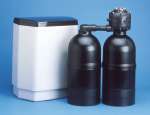Search engine visitors - click here to access entire "$ensible Home" web site
Click here to see a descriptive illustration of several types of new water softeners.
Dear Jim: I recently stayed at a friend's home that had softened water. The shower water felt wonderful and even washed clothes felt nicer. Is this from the soft water, and if so, what kind of softener should I get? - May R.

A: Properly softened water can feel better in the shower. This is particularly noticeable in one's hair after being washed. You will also find there is no ring in the bathtub or hard-to-clean deposits. The faucet valve seats stay cleaner resulting in fewer dripping faucets.
Clothes may also feel nicer when they are washed in softened water. When using unsoftened hard water, calcium and other mineral deposits remain in the fabric. What is worse than the way they feel is that these calcium deposits grind away at the fabric as you wear the clothes. This causes them to prematurely wear out and lose their colorful like-new appearance.
Check with your local water works department to determine if your water is hard enough to benefit from installing a water softener. The Water Quality Association (WQA) considers water with 4 grains of hardness per gallon to be the "hard water" threshold. Much household water is harder than this.
You can expect a water softener's annual operating cost to be about $75 for the regeneration salt and extra water it uses during regeneration cycles. Some models have totally mechanical controls which use no electricity. Even the electronic digital models use very little electricity for the controls.
The most effective type of water softener uses an ion exchange process. The hard ions (typically calcium and magnesium) in the incoming water are exchanged for simple sodium ions which are soluble in the water. The sodium content is very low, but if you are concerned about sodium in your diet, just run a non-softened water pipe to your sink or drinking water filter.
Once the softener's core is saturated with hard ions, it is regenerated with more sodium from a brine tank so it can begin softening the water again. The core is flushed out after regeneration so no free sodium remains.
When selecting a water softener, you should consider its size and the type of controls. The optimum size (in grains of hardness) depends on how much water your family uses and how hard your water is. If you have very hard water, a small core will have to be regenerated too often for efficiency.
Demand-initiated controls are best. These are programmed by the installer for your specific water hardness. When the programmed number of gallons of water are used, it automatically regenerates. It is often set to start at 1:00 a.m. when little softened water is needed. A two-tank softener system switches between the tanks so softened water is continuously available.
Instant Download Update Bulletin No. 496 - buyer's guide of 10 efficient water softeners, types of controls, softening capacities, regeneration cycle times, physical sizes of the units (cabinets, resin tanks, brine tanks) features, prices, diagrams and description of basic water softening system process, many illustrations of various models, annual water costs to operate chart, sizing guideline and water hardness charts.
Dear Jim: My daughter left for college this year so her bedroom is unused. I thought about blocking of the return air register from that room since it is not used. Will this cut our utility bills at all? - Sandi L.
A: Is does make sense to block the cold air return register as long as there are return registers in other rooms. Also close the warm air register. There is no need to keep that room toasty warm if no one is using it.
Don't do this to many rooms in your house or you may increase the air flow resistance in the entire system. If this happens and the air flow through the furnace is reduced, its efficiency can be adversely affected.